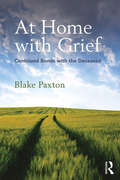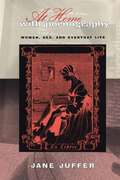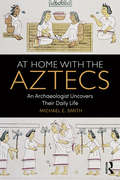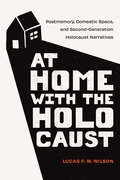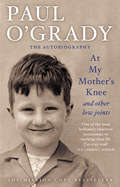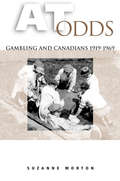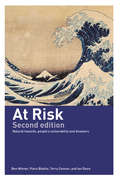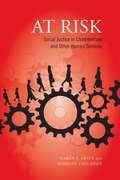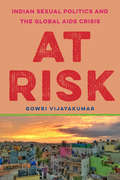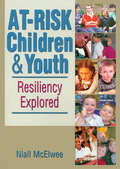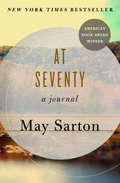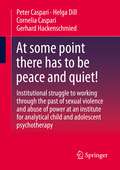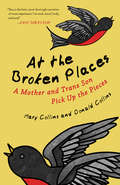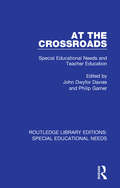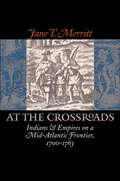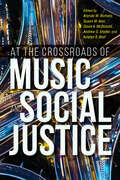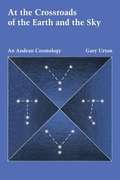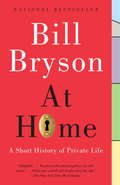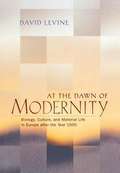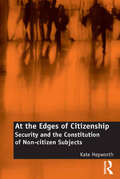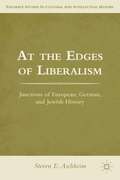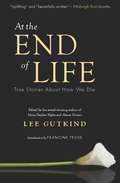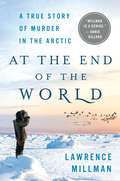- Table View
- List View
At Home with Grief: Continued Bonds with the Deceased (Writing Lives: Ethnographic Narratives)
by Blake PaxtonWhat would you say to a deceased loved one if they could come back for one day? What if you can’t just ‘move on’ from grief? At Home with Grief: Continued Bonds with the Deceased chronicles Blake Paxton’s autoethnographic study of his continued relationship with his deceased mother. In the 90s, Silverman, Klass, and Nickman argued that after the death of a loved one, the bond does not have to be broken and the bereaved can find many ways to connect with memories of the dead. Building on their work, many other bereavement scholars have discussed the importance of not treating these relationships as pathological and have suggested that more research is needed in this area of grief studies. However, very few studies have addressed the communal and everyday subjective experiences of continuing bonds with the deceased, as well as how our relationship with our grief changes in the long term. In this book, Blake Paxton shows how a community in southern Illinois continues a relationship with one deceased individual more than ten years after her death. Through this gripping autoethnographic account of his mother’s struggles with a rare cancer, her death, and his struggles with sexuality, he poses possibilities of what might happen when cultural prescriptions for grief are challenged, and how continuing bonds with the dead may help us continue or restore broken bonds with the living.
At Home with Pornography: Women, Sexuality, and Everyday Life
by Jane JufferTwenty-five years after the start of the feminist sex wars, pornography remains a flashpoint issue, with feminists locked in a familiar argument: Are women victims or agents? In At Home with Pornography, Jane Juffer exposes the fruitlessness of this debate and suggests that it has prevented us from realizing women's changing relationship to erotica and porn. Over the course of these same twenty-five years, there has been a proliferation of sexually explicit materials geared toward women, made available in increasingly mainstream venues. In asking "what is the relationship of women to pornography?" Juffer maintains that we need to stop obsessing over pornography's transgressive aspects, and start focusing on the place of porn and erotica in women's everyday lives. Where, she asks, do women routinely find it, for how much, and how is it circulated and consumed within the home? How is this circulation and consumption shaped by the different marketing categories that attempt to distinguish erotica from porn, such as women's literary erotica and sexual self-help videos for couples? At Home with Pornography responds to these questions by viewing women's erotica within the context of governmental regulation that attempts to counterpose a "dangerous" pornography with the sanctity of the home. Juffer explorers how women's consumption of erotica and porn for their own pleasure can be empowering, while still acting to reinforce conservative ideals. She shows how, for instance, the Victoria's Secret catalog is able to function as a kind of pornography whose circulation is facilitated both by its reliance on Victorian themes of secrecy and privacy and on its appeals to the selfish pleasures of modern career women. In her pursuit to understand what women like and how they get it, Juffer delves into adult cable channels, erotic literary anthologies, sex therapy guides, cyberporn, masturbation, and sex toys, showing the varying degrees to which these materials have been domesticated for home consumption. Representing the next generation of scholarship on pornography, At Home with Pornography will transform our understanding of women's everyday sexuality.
At Home with the Aztecs: An Archaeologist Uncovers Their Daily Life
by Michael SmithAt Home with the Aztecs provides a fresh view of Aztec society, focusing on households and communities instead of kings, pyramids, and human sacrifice. This new approach offers an opportunity to humanize the Aztecs, moving past the popular stereotype of sacrificial maniacs to demonstrate that these were successful and prosperous communities. Michael Smith also engagingly describes the scientific, logistic and personal dimensions of archaeological fieldwork, drawing on decades of excavating experience and considering how his research was affected by his interaction with contemporary Mexican communities. Through first-hand accounts of the ways archaeologists interpret sites and artifacts, the book illuminates how the archaeological process can provide information about ancient families. Facilitating a richer understanding of the Aztec world, Smith’s research also redefines success, prosperity and resilience in ancient societies, making this book suitable not only for those interested in the Aztecs but in the examination of complex societies in general.
At Home with the Holocaust: Postmemory, Domestic Space, and Second-Generation Holocaust Narratives
by Lucas F. WilsonAt Home with the Holocaust examines the relationship between intergenerational trauma and domestic space, focusing on how Holocaust survivors’ homes became extensions of their traumatized psyches that their children “inhabited.” Analyzing second- and third-generation Holocaust literature—such as Art Spiegelman's Maus, Jonathan Safran Foer's Everything Is Illuminated, Sonia Pilcer's The Holocaust Kid, and Elizabeth Rosner's The Speed of Light—as well as oral histories of children of survivors, Lucas F. W. Wilson's study reveals how the material conditions of survivor-family homes, along with household practices and belongings, rendered these homes as spaces of traumatic transference. As survivors’ traumas became imbued in the very space of the domestic, their homes functioned as material archives of their Holocaust pasts, creating environments that, not uncommonly, second-handedly wounded their children. As survivor-family homes were imaginatively transformed by survivors’ children into the sites of their parents’ traumas, like concentration camps and ghettos, their homes catalyzed the transmission of these traumas.
At My Mother's Knee...And Other Low Joints: Tales from Paul’s mischievous young years
by Paul O'GradyTHE MILLION COPY BESTSELLER'Warmly funny, dry and mischievous . . . Genuine and brilliant.' Daily MailPaul O'Grady is one of Britain's very best loved entertainers. He is known and adored by millions, whether as the creator of the acid-tongued Blonde Bombsite, Lily Savage, the presenter of the fantastically successful, award-winning Paul O'Grady Show on Channel 4 or the massive hit ITV show, For the Love of Dogs.Now, in his own unique voice, Paul O'Grady tells story of his early life in Irish Catholic Birkenhead that started him on the long and winding road from mischievous altar boy to national treasure. It is a brilliantly evoked, hilarious and often moving tale of gossip in the back yard, bragging in the corner shop and slanging matches on the front doorstep, populated by larger-than-life characters with hearts of gold and tongues as sharp as razors.At My Mother's Knee features an unforgettable cast of rogues, rascals, lovers, fighters, saints and sinners - and one iconic bus conductress. It's a book which really does have something for everyone and which reminds us that, when all's said and done, there's a bit of savage in all of us...Readers love At My Mother's Knee:'I laughed, I cried, I couldn't put it down and the characters really just jumped out of the page.' *****'Candid, heart warming and also hilarious.' *****'Wonderfully written, laugh out loud funny and poignant by turns.' *****
At Odds
by Suzanne MortonUsing a rich variety of historical sources, Suzanne Morton traces the history of gambling regulation in five Canadian provinces - Nova Scotia, Quebec, Ontario, Manitoba, and B.C. - from the First World War to the federal legalization in 1969. This regulatory legislation, designed to control gambling, ended a long period of paradox and pretence during which gambling was common, but still illegal.Morton skilfully shows the relationship between gambling and the wider social mores of the time, as evinced by labour, governance, and the regulation of 'vice.' Her focus on the ways in which race, class, and gender structured the meaning of gambling underpins and illuminates the historical data she presents. She shows, for example, as "Old Canada" (the Protestant, Anglo-Celtic establishment) declined in influence, gambling took on a less deviant connotation - a process that continued as charity became secularized and gambling became a lucrative fundraising activity eventually linked to the welfare state.At Odds is the first Canadian historical examination of gambling, a complex topic which is still met by moral ambivalence, legal proscription, and volatile opinion. This highly original study will be of interest to the undergraduate history or social science student, but will also hold the attention of a more general reader.
At Risk: Natural Hazards, People's Vulnerability and Disasters
by Piers Blaikie Terry Cannon Ian Davis Ben WisnerThe term 'natural disaster' is often used to refer to natural events such as earthquakes, hurricanes or floods. However, the phrase 'natural disaster' suggests an uncritical acceptance of a deeply engrained ideological and cultural myth. At Risk questions this myth and argues that extreme natural events are not disasters until a vulnerable group of people is exposed. The updated new edition confronts a further ten years of ever more expensive and deadly disasters and discusses disaster not as an aberration, but as a signal failure of mainstream 'development'. Two analytical models are provided as tools for understanding vulnerability. One links remote and distant 'root causes' to 'unsafe conditions' in a 'progression of vulnerability'. The other uses the concepts of 'access' and 'livelihood' to understand why some households are more vulnerable than others. Examining key natural events and incorporating strategies to create a safer world, this revised edition is an important resource for those involved in the fields of environment and development studies.
At Risk: Black Youth and the Creative Imperative in the Post–Civil Rights Era (Cultures of Childhood)
by Jennifer GriffithsJennifer Griffiths's At Risk: Black Youth and the Creative Imperative in the Post–Civil Rights Era focuses on literary representations of adolescent artists as they develop strategies to intervene against the stereotypes that threaten to limit their horizons. The authors of the analyzed works capture and convey the complex experience of the generation of young people growing up in the era after the civil rights movement. Through creative experiments, they carefully consider what it means to be narrowed within the scope of a sociological “problem,” all while trying to expand the perspective of creative liberation. In short, they explore what it means to be deemed an “at risk” youth. This book looks at crucial works beginning in 1968, ranging from Sapphire’s Push and The Kid, Walter Dean Myers’s Monster, and Dael Orlandersmith’s The Gimmick, to Bill Gunn’s Johnnas. Each text offers unique representations of Black gifted children, whose creative processes help them to navigate simultaneous hypervisibility and invisibility as racialized subjects. The book addresses the ways that adolescents experience the perilous “at risk” label, which threatens to narrow adolescent existence at a developmental moment that requires an orientation toward possibility and a freedom to experiment. Ultimately, At Risk considers the distinct possibilities and challenges of the post–civil rights era, and how the period allows for a more honest, multilayered, and forthright depiction of Black youth subjectivity against the adultification that forecloses potential.
At Risk
by Karen Swift Marilyn CallahanIn At Risk, Karen J. Swift and Marilyn Callahan examine risk and risk assessment in the context of professional practice in child protection, social work, and other human services. They argue that the tools, technologies, and practices used to measure risk to the individual have gone unquestioned and unstudied and that current methods of risk assessment may be distorting the principles of social justice.Central to this study is an examination of the everyday experiences of workers and parents engaged in risk assessment processes in Canadian child welfare investigations. Going beyond theory, Swift and Callahan highlight how risk evaluations play out in actual interactions with vulnerable people. Pointing out that standardized risk assessment tools do not take factors such as class, race, gender, and culture into account, At Risk raises important questions about the viability of risk management plans that are not tailored to individual situations.
At Risk: Indian Sexual Politics and the Global AIDS Crisis (Globalization in Everyday Life)
by Gowri VijayakumarIn the mid-1990s, experts predicted that India would face the world's biggest AIDS epidemic by 2000. Though a crisis at this scale never fully materialized, global public health institutions, donors, and the Indian state initiated a massive effort to prevent it. HIV prevention programs channeled billions of dollars toward those groups designated as at-risk—sex workers and men who have sex with men. At Risk captures this unique moment in which these criminalized and marginalized groups reinvented their "at-risk" categorization and became central players in the crisis response. The AIDS crisis created a contradictory, conditional, and temporary opening for sex-worker and LGBTIQ activists to renegotiate citizenship and to make demands on the state. Working across India and Kenya, Gowri Vijayakumar provides a fine-grained account of the political struggles at the heart of the Indian AIDS response. These range from everyday articulations of sexual identity in activist organizations in Bangalore to new approaches to HIV prevention in Nairobi, where prevention strategies first introduced in India are adapted and circulate, as in the global AIDS field more broadly. Vijayakumar illuminates how the politics of gender, sexuality, and nationalism shape global crisis response. In so doing, she considers the precarious potential for social change in and after a crisis.
At-Risk Children and Youth: Resiliency Explored
by Niall McElweeDiscover strategies to reinforce the strengths of the youngest members of society What assistance can be provided to a disadvantaged youngster to help them bounce back to conquer challenges while growing up? At-Risk Children and Youth analyzes the results from accumulated research on the risk and resiliency of children and youth in Ireland. Niall McElwee shines a crucial spotlight on the challenges facing children, including poor literacy and numeracy skills, poverty, distrust, and other difficult issues. Practical strategies are presented to help disadvantaged children and youth to overcome societal and self-imposed barriers for improvement. A detailed review and assessment is provided of the efficacy of Ireland’s Youth Encounter Projects. This important resource focuses on what works and what does not in youth services. At-Risk Children and Youth closely examines at-risk factors and what it specifically means to be ’at-risk’. Going further beyond the standard risk factors usually considered such as drug use or dropping-out of school, this probing text explores the full range of factors and coping and healing mechanisms. The author challenges several of the views and beliefs about risk and resiliency generally held by many in child and youth services and in society. This book is extensively referenced and includes helpful figures tables to clearly present information. Topics in At-Risk Children and Youth include: detailed breakdown of terms for risk behaviors and predictors of risk the issues of social class and social exclusion the impact of school difficulties on students, including truancy and poor academic standing building on student strengths the quality of the entirety of the school experience as a determination of success strategies for intervention a review of various literature on risk and resiliency a relational research model, including methodology and ethical issues description and functions of Youth Encounter Projects—and an assessment of their value at-risk youth perceptions of risk, in their own words results of risk studies over the past decade recommended changes in policies At-Risk Children and Youth is a valuable addition to the libraries of educators, students, and child and youth service providers everywhere.
At Seventy: A Journal
by May SartonWinner of the American Book Award: May Sarton&’s honest and engrossing journal of her seventieth year, spent living and working on the Maine coast. May Sarton&’s journals are a captivating look at a rich artistic life. In this, her ode to aging, she savors the daily pleasures of tending to her garden, caring for her dogs, and entertaining guests at her beloved Maine home by the sea. Her reminiscences are raw, and her observations are infused with the poetic candor for which Sarton—over the course of her decades-long career—became known. An enlightening glimpse into a time—the early 1980s—and an age, At Seventy is at once specific and universal, providing a unique window into septuagenarian life that readers of all generations will enjoy. At times mournful and at others hopeful, this is a beautiful memoir of the year in which Sarton, looking back on it all, could proclaim, &“I am more myself than I have ever been.&”
At some point there has to be peace and quiet!: Institutional struggle to working through the past of sexual violence and abuse of power at an institute for analytical child and adolescent psychotherapy
by Peter Caspari Helga Dill Cornelia Caspari Gerhard HackenschmiedThe book provides - for the first time in the German-speaking world - a comprehensive scientific contribution to the reappraisal of sexualized violence in a psychotherapy institute. The qualitative case study takes a look at decades of abuse of power and sexualized violence by the director of an analytical institute for children and young people. It shows that the psychotherapists involved in this system do not live up to central ideas and concepts of their profession: Silence, denial, rationalization, rejection of responsibility, and ignorance of those affected have for a long time prevented the uncovering of the acts and sustainable forms of coming to terms with them. The life of the institute is characterized by a dialectical tension between the necessity of processing and the desire for undisturbed functioning. This dynamic also proves to be analogous to the problem-solving patterns of psychotherapeutic patients. The case points to fundamental problems in the field of psychotherapy, which are primarily related to a structural power imbalance and pronounced dependency relationships both in the context of training and in the treatment setting. The findings of this empirical study are used to derive professional and organizational ethical considerations and - based on these - to formulate concrete recommendations for the prevention of sexualized violence in psychotherapy institutes.
At the Broken Places: A Mother and Trans Son Pick Up the Pieces
by Donald Collins Mary CollinsIn this collaborative memoir, a parent and a transgender son recount wrestling with their differences as Donald Collins undertook medical-treatment options to better align his body with his gender identity. As a parent, Mary Collins didn’t agree with her trans son’s decision to physically alter his body, although she supported his right to realize himself as a person. Raw and uncensored, each explains her or his emotional mindset at the time: Mary felt she had lost a daughter; Donald activated his “authentic self.” Both battled to assert their rights. A powerful memoir and resource, At the Broken Places offers a road map for families in transition.
At the Crossroads: Special Educational Needs and Teacher Education (Routledge Library Editions: Special Educational Needs #13)
by John Dwyfor Davies Philip GarnerFirst published in 1997. This book examines recent and contemporary trends in training teachers in special educational needs. It views initial teacher education and subsequent professional development as part of a continuum in which significant opportunities exist for innovation. It presents a series of chapters in support of this optimistic stance which provide practical examples of effective ways of working, written by authors who have direct experience in the field. For student teachers, tutors, lecturers and school-based mentors in both general subjects and SEN.
At the Crossroads
by Jane T. MerrittExamining interactions between native Americans and whites in eighteenth-century Pennsylvania, Jane Merritt traces the emergence of race as the defining difference between these neighbors on the frontier. Before 1755, Indian and white communities in Pennsylvania shared a certain amount of interdependence. They traded skills and resources and found a common enemy in the colonial authorities, including the powerful Six Nations, who attempted to control them and the land they inhabited. Using innovative research in German Moravian records, among other sources, Merritt explores the cultural practices, social needs, gender dynamics, economic exigencies, and political forces that brought native Americans and Euramericans together in the first half of the eighteenth century. But as Merritt demonstrates, the tolerance and even cooperation that once marked relations between Indians and whites collapsed during the Seven Years' War. By the 1760s, as the white population increased, a stronger, nationalist identity emerged among both white and Indian populations, each calling for new territorial and political boundaries to separate their communities. Differences between Indians and whites--whether political, economic, social, religious, or ethnic--became increasingly characterized in racial terms, and the resulting animosity left an enduring legacy in Pennsylvania's colonial history.
At the Crossroads of Music and Social Justice (Activist Encounters in Folklore and Ethnomusicology)
by Kyra D. Gaunt Steven Loza Charlotte W. Heth Paul Austerlitz Katie J. Graber Darci Sprengel Ho Chak Law Alexandria Carrico Erin E. Bauer Rebekah E. MooreMusic is powerful and transformational, but can it spur actual social change? A strong collection of essays, At the Crossroads of Music and Social Justice studies the meaning of music within a community to investigate the intersections of sound and race, ethnicity, religion, gender, sexual orientation, and differing abilities. Ethnographic work from a range of theoretical frameworks uncovers and analyzes the successes and limitations of music's efficacies in resolving conflicts, easing tensions, reconciling groups, promoting unity, and healing communities. This volume is rooted in the Crossroads Section for Difference and Representation of the Society for Ethnomusicology, whose mandate is to address issues of diversity, difference, and underrepresentation in the society and its members' professional spheres. Activist scholars who contribute to this volume illuminate possible pathways and directions to support musical diversity and representation.At the Crossroads of Music and Social Justice is an excellent resource for readers interested in real-world examples of how folklore, ethnomusicology, and activism can, together, create a more just and inclusive world.
At the Crossroads of the Earth and the Sky: An Andean Cosmology
by Gary UrtonBased on fieldwork in Misminay, Peru, Gary Urton details a cosmology in which the Milky Way is central. This is the first study that provides a description and analysis of the astronomical and cosmological system in a contemporary community in the Americas.
At the Dark End of the Street: Black Women, Rape, and Resistance--A New History of the Civil Rights Movement from Rosa Parks to the Rise of Black Power
by Danielle L. McGuireHere is the courageous, groundbreaking story of Rosa Parks and Recy Taylor—a story that reinterprets the history of America's civil rights movement in terms of the sexual violence committed against Black women by white men. "An important step to finally facing the terrible legacies of race and gender in this country.&” —The Washington PostRosa Parks was often described as a sweet and reticent elderly woman whose tired feet caused her to defy segregation on Montgomery&’s city buses, and whose supposedly solitary, spontaneous act sparked the 1955 bus boycott that gave birth to the civil rights movement. The truth of who Rosa Parks was and what really lay beneath the 1955 boycott is far different from anything previously written. In this groundbreaking and important book, Danielle McGuire writes about the rape in 1944 of a twenty-four-year-old mother and sharecropper, Recy Taylor, who strolled toward home after an evening of singing and praying at the Rock Hill Holiness Church in Abbeville, Alabama. Seven white men, armed with knives and shotguns, ordered the young woman into their green Chevrolet, raped her, and left her for dead. The president of the local NAACP branch office sent his best investigator and organizer—Rosa Parks—to Abbeville. In taking on this case, Parks launched a movement that exposed a ritualized history of sexual assault against Black women and added fire to the growing call for change.
At the Dawn of Belt and Road: China in the Developing World (G - Reference, Information and Interdisciplinary Subjects)
by Andrew Scobell Bonny Lin Howard J. Shatz Michael Johnson Larry Hanauer Michael S. Chase Astrid Stuth Cevallos Ivan W. Rasmussen Arthur Chan Aaron Strong Eric Warner Logan MaChina has always viewed itself as a vulnerable underdeveloped country. In the 1990s, it began negotiating economic agreements and creating China-centric institutions, culminating in the 2000s in numerous institutions and ultimately the Belt and Road Initiative. The authors analyze China’s political and diplomatic, economic, and military engagement with the Developing World and discuss specific countries that are most important to China.
At the Dawn of Modernity: Biology, Culture, and Material Life in Europe After the Year 1000
by David LevineAn accessible introduction to the origins of the modern Western world, using demographic history as a lens for examining possible accounts of transformations of economic, political, and domestic life in Western Europe between A. D. 1000 and 1400.
At the Edges of Citizenship: Security and the Constitution of Non-citizen Subjects
by Kate HepworthProposing a new, dynamic conception of citizenship, this book argues against understandings of citizenship as a collection of rights that can be either possessed or endowed, and demonstrates it is an emergent condition that has temporal and spatial dimensions. Furthermore, citizenship is shown to be continually and contingently reconstituted through the struggles between those considered insiders and outsiders. Significantly, these struggles do not result in a clear division between citizens and non-citizens, but in a multiplicity of states that are at once included within and excluded from the political community. These liminal states of citizenship are elaborated in relation to three specific forms of non-citizenship: the ’respectable illegal, the ’intimate foreigner’ and the ’abject citizen’. Each of these modalities of citizenship corresponds to either the figure of the clandestino/a or the nomad as invoked in the 2008 Italian Security Package and a second set of laws, commonly referred to as the ’Nomad Emergency Decree’. Exploring how this legislation affected and was negotiated by individuals and groups who were constituted as ’objects of security’, author Kate Hepworth focuses on the first-hand experience of individuals deemed threats to the nation. Situated within the field of human geography, the book draws on literature from citizenship studies, critical security studies and migration studies to show how processes of securitisation and irregularisation work to delimit between citizens and non-citizens, as well as between legitimate and illegitimate outsiders.
At the Edges of Liberalism
by Steven E. AschheimThe essays in this volume seek to confront some of the charged meeting points of European - especially German - and Jewish history. All, in one way or another, explore the entanglements, the intertwined moments of empathy and enmity, belonging and estrangement, creativity and destructiveness that occurred at these junctions.
At the End of Life
by Francine Prose Lee GutkindWhat should medicine do when it can't save your life?The modern healthcare system has become proficient at staving off death with aggressive interventions. And yet, eventually everyone dies--and although most Americans say they would prefer to die peacefully at home, more than half of all deaths take place in hospitals or health care facilities.At the End of Life--the latest collaborative book project between the Creative Nonfiction Foundation and the Jewish Healthcare Foundation--tackles this conundrum head on. Featuring twenty-two compelling personal-medical narratives, the collection explores death, dying and palliative care, and highlights current features, flaws and advances in the healthcare system.Here, a poet and former hospice worker reflects on death's mysteries; a son wanders the halls of his mother's nursing home, lost in the small absurdities of the place; a grief counselor struggles with losing his own grandfather; a medical intern traces the origins and meaning of time; a mother anguishes over her decision to turn off her daughter's life support and allow her organs to be harvested; and a nurse remembers many of her former patients.These original, compelling personal narratives reveal the inner workings of hospitals, homes and hospices where patients, their doctors and their loved ones all battle to hang on--and to let go.
At the End of the World: A True Story of Murder in the Arctic
by Lawrence MillmanAt the End of the World is the remarkable story of a series of murders that occurred in an extremely remote corner of the Arctic in 1941. Those murders show that senseless violence in the name of religion is not only a contemporary phenomenon, and that a people as seemingly peaceful as the Inuit can become unpeaceful at the drop of a hat or, in this instance, a meteor shower. At the same time, the book is a warning cry against the destruction of what’s left of our culture’s humanity, along the destruction of the natural world. Has technology deprived us of our eyes? the author asks. Has it deprived the world of birds, beasts, and flowers? Lawrence Millman's At the End of the World is a brilliant and original book by one of the boldest writers of our era.
